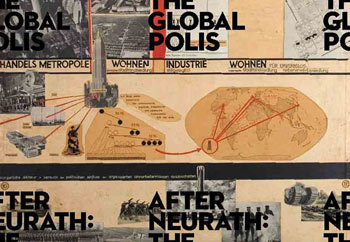After Neurath
dal 10/2/2008 al 5/4/2008
Segnalato da
10/2/2008
After Neurath
Stroom Den Haag, The Hague
The Global Polis. The exhibition looks at how he attempted to do so in disciplines as varied as architecture, urbanism, graphic design and planning. It concentrates on Neurath's collaborations with Cornelis van Eesteren, Le Corbusier, Margarete Schütte-Lihotzky, Paul Otlet, and other seminal modernists, and tries to raise the question of what a global public space could mean today.

Otto Neurath (1882 -1945) is a long-neglected giant in the history of the Information Age. He was a philosopher who despised academic philosophy, a museum director who hated conventional museums and a city planner who was critical of the city. He was especially eager to promote participatory forms of democratic exchange (he wanted to create a ‘global polis’). The exhibition ‘After Neurath: The Global Polis’ looks at how he attempted to do so in disciplines as varied as architecture, urbanism, graphic design and planning. It concentrates on Neurath’s collaborations with Cornelis van Eesteren, Le Corbusier, Margarete Schütte-Lihotzky, Paul Otlet, and other seminal modernists, and tries to raise the question of what a global public space could mean today. The exhibition is part of Stroom’s ‘After Neurath’ programme, which focuses on the historical background and the actual relevance of Otto Neurath.
The exhibition is structured in three 'acts'. The first act, 'The Communal City', examines Neurath's role in Vienna's extraordinary 'self-help' cooperative settlement movement, which inspired tremendous optimism in architects and planners. The second act, 'The World City', examines Neurath's efforts to internationalize mass education and social enlightenment through collaborations with Paul Otlet, Le Corbusier and others. The third act, 'The Functional City', looks at his work with the Congrès Internationaux d'Architecture Moderne (CIAM) and the planner and architect Cornelis van Eesteren specifically. This section explores Neurath's struggles with the mass media and modernist architecture on the eve of the rise of fascism in Europe. It also raises deeper questions about the links between culture and politics today.
The show includes a combination of graphic charts, brochures, posters, portfolios, films and models. One of the signature pieces in the exhibition is a 5-meter-long 'Historical Table' which shows the development of the city -from prehistoric cave to modern metropolis. The CIAM architects Rudolf Steiger and Wilhelm Hess made it in 1935 in collaboration with Georg Schmidt for an exhibition at the Stedelijk Museum in Amsterdam. It was shown for one day before it was taken down by exhibition organizers who feared political persecution. This is the first time it has been shown in Holland since.
The exhibition is curated by Nader Vossoughian, Assistant Professor of Architecture at the New York Institute of Technology and author of the publication 'Otto Neurath. The Language of the Global Polis' (NAi Publishers, in collaboration with Stroom Den Haag, 2008).
Exhibition design: Project Projects, New York.
The exhibition is made possible in part by: Mondriaan Foundation; Casema Culture Fund; NAi Rotterdam; Eidgenössische Technische Hochschule Zürich (Switzerland); University of Reading (UK); Wienbibliothek im Rathaus, Vienna (Austria); Imperial War Museum (UK); Universität für angewandte Kunst (Vienna), Fondation Le Corbusier (F); Mundaneum (Mons, Belgium).
Image: the invitation card with detail of the 'Historical Table’ (1935) by Rudolf Steiger, Wilhelm Hess, Georg Schmidt
Stroom Den Haag
Hogewal 1-9
2514 HA The Hague The Netherlands
Opening hours: Wednesday-Sunday 12-5 pm



